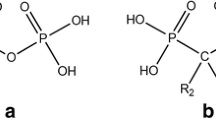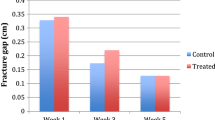Summary
Implants of demineralized bone matrix induce new bone formation. In order to estimate the possible clinical usefulness of this phenomenon, autologous cancellous bone grafts were compared with composite grafts of bone matrix and marrow. Cancellous bone from the tuber ischii of the rabbit was transplanted to a preformed radial defect in the same animal. On the opposite side, a similar defect was filled with a mixture of either allogenous or autogenous bone-matrix particles and autogenous bone marrow. After 25 days, calcium 45 was injected intravenously. Three days later the animals were killed. Standardized segments of the rabbit's forearms, containing the middle of the defect, were cut out, ashed, and analyzed for 45Ca activity. No side difference in 45Ca deposition was found. The callus ash weight of the allogenous matrix-transplanted side was approximately 60% of that of the cancellous bone side. This side difference of ash weights corresponds to the estimated initial mineral content of the cancellous graft. Nontransplanted defects had very low ash weight and 45Ca activity. Thus, in the rabbit, composite grafts of bone matrix and marrow produce a bone yield comparable to that of cancellous bone.
Similar content being viewed by others
References
Albrektsson T (1979) Healing of bone grafts. Thesis, Göteborg
Aspenberg P, Wittbjer J, Thorngren K-G (1986) Particulated bone matrix as an injectable bone graft in rabbit radius defects. Clin Orthop 206:261–269
Bauer FCH, Nilsson OS, Törnkvist H (1984) Formation and resorption of bone induced by decalcified bone matrix in rats. Clin Orthop 191:139–143
Burwell RG (1964) Studies in the transplantation of bone. VII. The fresh composite homograft-autograft of cancellous bone. An analysis of factors leading to osteogenesis in marrow-containing bone grafts. J Bone Joint Surg [Br] 46:110–140
Glowacky J, Murray JE, Kaban LB, Folkman J, Mulliken JB (1981) Application of the biological principle of induced osteogenesis for craniofacial defects. Lancet 1:959–962
Lindholm TS, Nilsson OS, Lindholm TC (1982) Extraskeletal and intraskeletal new bone formation induced by demineralized bone matrix combined with bone marrow. Clin Orthop 171:251–255
Oikarinen J (1982) Experimental spinal fusion with decalcified bone matrix and deep-frozen allogenic bone in rabbits. Clin Orthop 167:210–218
Peck WA, Reddi AH, Gordon SL (1984) Local mechanism that regulate bone formation: the subject of a recent NIH-sponsored workshop. Editorial. Calcif Tissue Int 36:1–3
Rönningen H, Solheim L, Langeland N (1985) Bone formation enhanced by induction. Bone growth in titanium implants in rats. Acta Orthop Scand 56:67–71
Simmons DJ, Lesker PA, Ellsasser JC (1975) Survival of osteocompetent marrow cells in vitro and the effect of PHA stimulation on osteoinduction in composite bone grafts. Proc Soc Exp Biol Med 148:986–990
Simmons DJ, Loeffelman K, Frier C, McCoy R, Friedman B, Melville S, Kaku AJ (1984) Circadian changes in the osteogenic competence of marrow stromal cells. In: Haus E, Kabat HF (eds) Chronobiology 1982–1983. Karger, Basel, pp 37–42
Syftestad GT, Urist MR (1979) Degradation of bone matrix morphogenetic activity by pulverization. Clin Orthop 141:281–286
Takagi K, Urist MR (1982) The role of bone marrow in bone morphogenetic proline-induced repair of massive diaphyseal defects. Clin Orthop 171:224–231
Tuli SM, Gupta KB (1981) Bridging of large chronic osteoperiosteal gaps by allogenic decalcified bone matrix implants in rabbits. J Trauma 21:894–898
Urist MR (1981) Bone transplants and implants. In: Urist MR (ed) Fundamental and clinical bone physiology. Lippincott, Philadelphia, pp 331–368
Urist MR (1983) Chemosterilized antigen-extracted surface-demineralized autolysed allogeneic (AAA) bone for arthrodesis. In: Friedlander GE, Mankin H, Sell KW (eds) Osteochondral grafts. Little, Brown & Co, Boston, pp 193–201
Wittbjer J, Palmer B, Thorngren K-G (1982) Osteogenetic properties of reimplanted decalcified and undecalcified autologous bone in the rabbit radius. Scand J Plast Reconstr Surg 16:239–244
Author information
Authors and Affiliations
Rights and permissions
About this article
Cite this article
Aspenberg, P., Wittbjer, J. & Thorngren, K.G. Bone matrix and marrow versus cancellous bone in rabbit radial defects. Arch. Orth. Traum. Surg. 106, 335–340 (1987). https://doi.org/10.1007/BF00456866
Received:
Issue Date:
DOI: https://doi.org/10.1007/BF00456866




